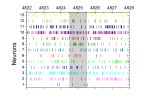EPJ B Highlight - Persistent sync for neurons
- Details
- Published on 03 November 2012

Under the scrutiny of mathematical tools designed to study complex networks, rats’ neurons reveal steady neural network coordination regardless of the animals’ behaviour
A team of Brazilian physicists working with neuroscientists studying freely behaving rats have found that their neurons often act in precise coordination over time, in a study just published in EPJ B. These findings stem from the work of Bruno Silva, a researcher at Bahia Federal University in Salvador, and his colleagues from other universities in the Northeastern region of Brazil, and suggest that neuronal networks’ memory could be explored in the future.
Because neurons are connected with each other, acting as operational units in the brain, they can be considered as a complex system. The authors thus relied on a theory traditionally used to study complex networks to confirm whether the firing frequency of a given neuron is correlated with that of other brain areas.
Silva and his colleagues constructed a model in which a network node represents a neuron and a network link is included between a pair of nodes whenever their firing rates are correlated. Instead of focusing on few large networks with thousands of nodes as studied by techniques such as Magnetic Resonance Imaging, the authors prepared detailed statistics on the records of a large set (~10,000) of smaller networks.
They found that, irrespective of the behavioral state of the animal , the number of networks with highly correlated activity in distinct brain areas can be represented in a fat-tailed graph representing a widespread probability of such correlation happening. This suggests that such connectivity associated with a specific function of the brain persists over time. Thus, memories in neuronal functional networks could very well be investigated in the future.
Finally, the authors also realised that what remains nearly constant in the brain is not the actual function of individual neurons but aspects of the network structure itself.
Statistical characterization of an ensemble of functional neural networks. B. B. M. Silva, J. G. V. Miranda, G.Corso, M. Copelli, N. Vasconcelos, S. Ribeiro, R. F. S. Andrade (2012), European Physical Journal B 85: 358, DOI: 10.1140/epjb/e2012-30481-7




